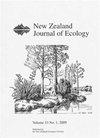对氨基丙烯酮(PAPP)作为控制新西兰霍克湾野猫的工具
IF 1.4
3区 环境科学与生态学
Q3 ECOLOGY
引用次数: 2
摘要
野猫对本地野生动物的影响越来越受到全世界的重视,因此对野猫的管理势在必行。由于新西兰的2050年无捕食者目标导致了更大、更雄心勃勃的景观规模计划,因此对稳定、高效的工具有着重要的需求。对氨基丙烯酮(PAPP)于2011年首次在新西兰以PredaSTOP®的名义注册,用于治疗野猫和白鼬,与目前使用的毒素相比,它对野猫具有更高的靶向特异性。继2017年在Hawke 's Bay的Toronui站成功试验后,2018年在Hawke 's Bay的Poutiri Ao ' Tāne项目区进行了9123公顷的大规模操作。在Opouahi站(治疗点)和Waitere站(非治疗点)使用相机陷阱监测野猫的相对丰度。一个由287个饵站组成的网络在整个处理场地500米的网格间隔内建立。两次使用无毒预喂肉末饵料后,两次使用有毒PAPP饵料。PAPP诱饵被染成绿色,在诱饵中心含有80 mg PredaSTOP®。PredaSTOP®的每次应用包括放置在每个诱饵站两端的两个诱饵。从至少130个饵料站清除了有毒饵料。我们假设至少有130只野猫可能被杀死,导致手术后野猫的相对丰度降低39%。我们的研究结果表明,PAPP有潜力与其他方法一起成为一种有用的管理工具。本文章由计算机程序翻译,如有差异,请以英文原文为准。
Using para-aminopropiophenone (PAPP) as a tool to control feral cats in Hawke’s Bay, New Zealand
The impact of feral cats on native wildlife is becoming increasingly recognised worldwide, making their management a necessity. As New Zealand’s Predator Free 2050 goal leads to larger and more ambitious landscape scale programmes, there is an important need for costand time-effective tools. Para-aminopropiophenone (PAPP) was first registered in New Zealand for feral cats and stoats in 2011 under the name PredaSTOP® and has higher target specificity for feral cats than currently used toxins. Following a successful trial of PAPP on Toronui Station, Hawke’s Bay in 2017, a larger operation was undertaken in 2018 across 9123 ha of the Poutiri Ao ō Tāne project area in Hawke’s Bay. Camera traps were used to monitor the relative abundance of feral cats on Opouahi Station (treatment site) and at Waitere Station(non-treatment site). A network of 287 bait stations was established in 500 m grid spacings across the treatment site. Two applications of non-toxic pre-feed minced meat baits were followed by two applications of toxic PAPP baits. PAPP baits were dyed green and contained 80 mg of PredaSTOP® in the centre of the bait. Each application of PredaSTOP® consisted of two baits placed at either end of each bait station. Toxic baits were removed from at least 130 bait stations. We assume that ≥ 130 feral cats are likely to have been killed, resulting in a 39% reduction in the relative abundance of feral cats after the operation. Our results suggest that PAPP has the potential to be a useful management tool across large areas alongside other methods.
求助全文
通过发布文献求助,成功后即可免费获取论文全文。
去求助
来源期刊

New Zealand Journal of Ecology
环境科学-生态学
CiteScore
3.00
自引率
12.50%
发文量
35
审稿时长
>36 weeks
期刊介绍:
The New Zealand Journal of Ecology is a biannual peer-reviewed journal publishing ecological research relevant to New Zealand/Aotearoa and the South Pacific. It has been published since 1952 (as a 1952 issue of New Zealand Science Review and as the Proceedings of the New Zealand Ecological Society until 1977). The Journal is published by the New Zealand Ecological Society (Inc.), and is covered by Current Contents/Agriculture, Biology and Environmental Science, GEOBASE, and Geo Abstracts.
 求助内容:
求助内容: 应助结果提醒方式:
应助结果提醒方式:


